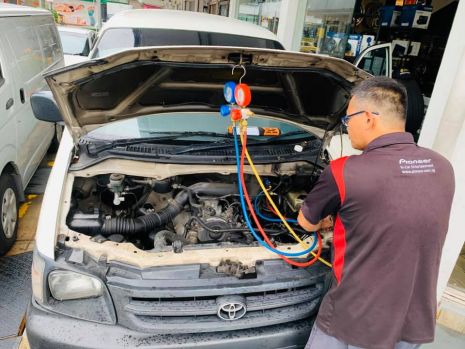Ad information
Air-Con Flushing (All Car Makes) @ $120
*price quoted before GST
flush job is really to remove the oil and contaminants from the A/C system. In most cases, contaminants and debris will 'stick' to the oil. If you can remove all the oil, you will remove all the contamination.
It's always better to maintain than repair.

Flushing and cleaning the auto A/C system:
It is virtually impossible to replace an A/C compressor without flushing the system. The extent of flushing or cleaning is dependent on the amount of contamination and debris left in the system after the failure.
As an absolute minimum, the high side of the system should be flushed. That would include the hose from the compressor to the condenser, the condenser, and the hose from the condenser to the evaporator inlet. (Note: depending on the condenser design and the amount of debris, the condenser may have to be replaced). Receive driers or accumulators can NOT be flushed (by virtue of their design). Additionally, never attempt to flush a compressor.
Flushing is really cleaning the internal components of the A/C system. It's important to use an approved A/C flush that will not leave any residue in the system and will evaporate quickly. Use caution when selecting your flushing compound. Many A/C Flushes on the market use reclaimed solvents and chemicals that are not safe for the A/C system. Flushing can be accomplished with either an aerosol type flush (which does not require a flush gun) or a liquid pour type that is used with a flush gun.
Either type (aerosol or liquid) flush agent will work, however you must have access to 'dry' compressed air or nitrogen to 'push' the flush solvent through the system. Nitrogen is the preferred method because it is an inert gas and will not introduce any moisture into the system. After flushing, it is strongly recommended that an in-line filter be installed in order to catch any debris that may be left in the system.
Using pressure (air or nitrogen) behind the flush solvent will push it through the components (hoses, condenser, etc.) to remove both oil and debris. It's important to repeat the flush process several times, in both directions, until the flush solvent removed from the component is clear. Complete details on Flushing the Auto A/C System are available here.
Come visit us at Tampines Street 93, Blk 9002, #01-74 S528836
Ad information
Air-Con Flushing (All Car Makes) @ $120
*price quoted before GST
flush job is really to remove the oil and contaminants from the A/C system. In most cases, contaminants and debris will 'stick' to the oil. If you can remove all the oil, you will remove all the contamination.
It's always better to maintain than repair.

Flushing and cleaning the auto A/C system:
It is virtually impossible to replace an A/C compressor without flushing the system. The extent of flushing or cleaning is dependent on the amount of contamination and debris left in the system after the failure.
As an absolute minimum, the high side of the system should be flushed. That would include the hose from the compressor to the condenser, the condenser, and the hose from the condenser to the evaporator inlet. (Note: depending on the condenser design and the amount of debris, the condenser may have to be replaced). Receive driers or accumulators can NOT be flushed (by virtue of their design). Additionally, never attempt to flush a compressor.
Flushing is really cleaning the internal components of the A/C system. It's important to use an approved A/C flush that will not leave any residue in the system and will evaporate quickly. Use caution when selecting your flushing compound. Many A/C Flushes on the market use reclaimed solvents and chemicals that are not safe for the A/C system. Flushing can be accomplished with either an aerosol type flush (which does not require a flush gun) or a liquid pour type that is used with a flush gun.
Either type (aerosol or liquid) flush agent will work, however you must have access to 'dry' compressed air or nitrogen to 'push' the flush solvent through the system. Nitrogen is the preferred method because it is an inert gas and will not introduce any moisture into the system. After flushing, it is strongly recommended that an in-line filter be installed in order to catch any debris that may be left in the system.
Using pressure (air or nitrogen) behind the flush solvent will push it through the components (hoses, condenser, etc.) to remove both oil and debris. It's important to repeat the flush process several times, in both directions, until the flush solvent removed from the component is clear. Complete details on Flushing the Auto A/C System are available here.
Come visit us at Tampines Street 93, Blk 9002, #01-74 S528836
Merchant information
More items from this seller
Similar Items
Email Enquiry
* indicates compulsory field.













-Rear-Aircon-Blower.jpg)

.jpg)


-Rear-Aircon-Blower.jpg)
-Rear-Aircon-Blower.jpg)




-Rear-Aircon-Blower-Pic-1.jpg)




-Rear-Aircon-Blower.jpg)